Knowing what to do when pollutants build up in your fish tank is key to maintaining healthy water quality for your aquatic pets.

So how should you react when you need to lower the nitrate levels in a saltwater aquarium without causing shock to the fish and invertebrates inside?
Different tanks may have varying nitrate contents but still thrive as long as everything is within tolerable limits.
But what water test reading is within that safe range when you have a new or an established marine aquarium?
There are multiple ways to manage and control the high nitrate levels in a saltwater tank but the practice has shown me that the best results are achieved by implementing more than one control method at a time.
So now let’s get into it to break down these.
To understand the methods, however, an explanation as to how the nitrogen cycle works is necessary.
The first phase of a nitrogen cycle involves organic waste in the aquarium being converted into ammonia (NH3), which in turn further degrades into a harmful substance called nitrite (NO2-).
This is achieved by Nitrosomonas — a colony of bacteria that feeds on ammonia by oxidizing it.
The Nitrobacter – another colony of nitrifying bacteria – consumes these nitrites while releasing the less harmful nitrates as a by-product. Nitrate is the final product in the nitrogen cycle.
Since nitrates do not convert into another form of nitrogen on their own, the fish-keeper has to devise ways to reduce their levels.
Without human intervention, nitrate will continue to accumulate in the fish tank until the whole closed system is too polluted to harbor aquatic life.
What is the Acceptable Level of Nitrate for a Saltwater Reef and Fish-Only Aquarium?
Nitrate only becomes harmful to fish and invertebrates when allowed to accumulate for prolonged periods of time.
The acceptable Nitrate levels in a saltwater aquarium are defined as:
- Saltwater aquarium fish can put up with higher levels of nitrates compared to freshwater fish. So for a marine, fish-only aquarium, an acceptable level of nitrate content would be up to 40 PPM (parts per million).
- A safe level of nitrate for invertebrates and corals in a reef aquarium would be 2 PPM since the invertebrates are generally more delicate, and therefore sensitive to contaminants. Though the more resilient corals would survive this, anything 5 ppm may prove to be too high and potentially lethal to the more fragile anemones and coral.
Author’s note: Some aquarists intentionally dose their reef tanks with more Nitrate to supposedly improve coral coloration. However, what’s important for a thriving reef colony is not the amount of Nitrate but rather maintaining the correct Phosphate to Nitrate ratio, also known as the Redfield ratio.
The Phosphate content in the reef tank should be significantly higher than the Nitrate or you risk bleaching your corals. However, high Phosphate can induce the growth of unwanted algae in the saltwater aquarium.
Anyway, saltwater fish can tolerate higher nitrate content than the amounts mentioned above.
However, it should be noted that prolonged exposure to such environments may eventually affect their health and shorten their lifespan. Fish deaths may come slowly, but surely and you could expect other side effects such as slowed growth, and a weakened immune system.
This condition in pet fish is called nitrate toxicosis. From my experience and observations, there are many cases of aquariums being kept by the book, with nitrates on the higher end, when suddenly the fish start to show signs of severe poisoning.
What Makes Nitrate Levels Rise in a Saltwater Fish Tank?
Since Nitrate in a marine tank results from degrading organic matter, the rise of it is tied to the amount of waste the closed ecosystem generates.
Organic waste itself comes from various sources.
Have a look at the common causes of rising nitrate levels in a saltwater aquarium:
- Overfeeding the fish.
In fact, overfeeding is the primary cause of high nitrate content in a recently started saltwater tank.
When the fish are provided with more than they need, the abundant food particles become organic waste and rot on the tank’s bottom.
Also, fish that eat a lot will evidently produce a lot more waste.
More livestock means more waste in the aquarium, which in turn piles up nitrates.
That’s especially true for confined tanks that have too many fish in them.
One needs to keep a manageable fish population according to the size and water volume of the aquarium to minimize this effect.
Another unfortunate consequence of an overstocked aquarium is that when a fish dies it can go unnoticed for days.
You should always remove dead fish from your tank as soon as possible because the rotting corpse may cause the Ammonia levels in the water to rise and kill the remaining fish. You can check this resource on how to lower Ammonia.
If the filter media is not cleaned regularly or thoroughly enough, the gunk accumulates and hikes up the nitrate levels in the water.
In a marine aquarium system, the de-nitrifying bacteria that inhabit porous surfaces such as live rock and live sand convert nitrate into harmless Nitrogen.
However, it takes time and certain anaerobic conditions before a new saltwater tank could have its relatively high nitrates under control.
The de-nitrifying bacteria are only fully developed after 6 or more months, given their environmental requirements are met.
If denitrifying bacteria have not yet developed the only viable way to export nitrate is through water changes.
Keeping water for a long time without changing it lets nitrate levels gradually elevate until they become a threat to your marine aquarium.
How to Remove and Control the High Nitrate Contents?
It’s crucial to learn the methods for lowering the nitrate levels in your saltwater aquarium and diligently practice them if you want to keep a healthy system in the long run.
There are several techniques to try, and you can combine them for better results.
How many techniques you apply should be determined by the level of contamination and how fast you would want to get rid of it.
To lower or altogether remove high nitrates from a saltwater aquarium you can:
1. Replace aquarium water periodically.
Regular water changing helps to get nitrates down and maintain a healthy fish and invertebrate environment in your aquarium. However, since nitrates are ions, a sudden drop could potentially lead to impaired osmoregulation in fish.
Failed Osmoregulation from changing too much aquarium water at once will make it difficult for marine inhabitants to regulate their body fluids. To safely reduce the nitrate content, without causing osmotic shock to marine fish, you should replace only a portion of the aquarium water.
Removing a maximum of 50% per weekly session is advisable since that is not going to affect the water parameters in the aquarium adversely.
An even better approach is to carry out multiple smaller water changes of 15% of the total water volume, executed an hour or two apart.
To avoid the reintroduction of NO3– many hobbyists use Reverse Osmosis (RO) water or other filtered water.
They then remineralize the purified water with essential aquarium salts.
If done correctly and regularly, a partial water change is a very effective method to lower the nitrate levels in a saltwater reef or fish-only tank.
Having your own RO system at home is very cost-efficient when keeping a marine aquarium. You can check one of the best units for that by clicking here.
2. Collect organic waste with a protein skimmer.
A protein skimmer collects and eliminates the organic compounds in the water before they are able to break down into nitrate.
In fact, the main reason that protein skimmers are so popular with aquarists is their ability to indirectly get the nitrates down in more contaminant-sensitive systems such as coral reef aquariums.
Bear in mind that, to work efficiently, a protein skimmer needs to be the right size for the tank’s water volume.
3. Grow macroalgae in a refugium.
Macroalgae are essential in a marine aquarium since they feed on sources of nitrogen for growth. Essentially, they will use up the free Nitrate in the system.
Macroalgae are best grown in a separate tank connected to your display one, called a refugium.
To lower the nitrates in a saltwater aquarium quickly, you should consider a type of macroalgae that grows really fast such as the Chaetomorpha.
Put a small ball of Chaetomorpha algae in your refugium and provide it with an inexpensive LED grow light that mainly emits wavelengths in the red spectrum.
The red spectrum will maximize the growth factor, which in turn will allow the macroalgae to suck up more nitrate in the process. To save you a couple of hours of research you can check this list of extremely effective LED refugium lights.
Anyway, another option is to actually make a dedicated planted saltwater tank and connect its circulation to your main display one. The pretty marine plants that can be grown this way are usually types of macroalgae and it’s not unseen for people to only have those in their display aquarium.
4. Control the fish food offerings.
Feeding fish sparingly can significantly reduce the high nitrate content in your saltwater tank.
This is especially important if the goal is removing excess nitrates from a reef tank where the more sensitive corals can perish from the contamination.
The emphasis is on the amount you give the fish per feeding and the frequency at which they are fed.
One good practice is to include a fasting day in their regimen.
This means skipping feeding for a whole day.
Don’t worry about their tiny tummies – fish are equipped to endure at least a week without food. That’s because, in the wild, you don’t get to eat every single day.
Anyhow, if you don’t really feel confident in your ability to provide equal doses of food each time you can opt for an inexpensive automatic fish feeder. I personally am a fan of the battery-operated one from Eheim.
This model can turn out almost as durable as Eheim’s canister filters. If you do go that road consider getting their “food station” too. This station is essentially a chamber that delivers the meals in the same place every time.
This prevents food from floating around and allows it to soak and sink properly if needed.
5. Add organic Carbon with vodka dosing.
Vodka dosing is a relatively interesting concept but it has become one of the best ways to reduce the high nitrates in reef systems due to its efficiency.
Basically, there are marine heterotrophic bacteria that take in carbon, nitrate, and phosphate as their key nutrients when they multiply.
The idea behind this method is that you provide the bacteria with a source of organic carbon such as vodka or vinegar. When nitrates and phosphates are abundant they use them up along with the extra carbon.
The colony then grows exponentially, thereby lowering the nitrates levels in the water in the process.
The nitrate is not exported from the aquarium system by this method.
It only gets transformed to bacterial biomass, so you’ll still need to physically remove that.
The overpopulation of bacteria will build up a slimy film on the water’s surface in your tank.
The protein skimmer will collect the bacterial biomass.
For better nitrate control when using this method, you should be dosing vodka continually.
That being said, here’s how to dose vodka to your reef tank:
- Dose 0.2 ml of vodka with 40% alcohol content per 25 gallons of aquarium water daily for the first 3 days.
- The next 3 days increase the daily vodka dosage to 0.4 ml per 25 gallons of water.
- The following week you can safely dose 1 ml of vodka per 25 gallons of water each day.
- From then on, increase the daily dose by 0.7 ml each week. Do that until you bring down the nitrates in the aquarium water to the desired levels.
- When the drop in nitrates is achieved cut the vodka dose in half and maintain that as an ongoing tempo.
6. Manage an optimal bioload for the tank’s size.
Research each particular fish you want to keep and stock your aquarium accordingly.
This doesn’t directly remove the nitrate from your aquarium, but it helps to reduce the produced levels.
7. Set up a Sulfur reactor.
Sulfur Nitrate reactors are relatively unpopular in the whole fish-keeping hobby.
A sulfur denitrator (reactor) will promote the growth of a specific kind of anaerobic bacteria, which are very efficient in converting Nitrate to Nitrogen molecules.
For this reason, these reactors are, perhaps, one of the most powerful ways to completely remove the nitrate content from any type of saltwater aquarium system.
However, it is extremely cost-efficient in the long run and the maintenance it requires is almost non-existent.
During my research, I have honestly tried to find someone with a bad experience from using a sulfur denitrator, but every story I stumbled upon was packed with success.
On top of being effective, sulfur denitrators also have a small footprint.
You also get to be flexible with the adjustment of nitrate contents in the water to more than 0 ppm if you’d like. Korallin seem to offer a solid sulfur denitrator chamber, which you can check out on Amazon.
8. Use a nitrate remover.
There are liquid or solid media supplements specifically designed to help with managing desirable nitrate levels in a reef aquarium at home.
Bear in mind that they do not fix the root cause of the problem but only deal with the nitrate that is already in the tank.
Some of these products are a type of media that provides porous surfaces which create “pockets” with no access to oxygen.
In the lack of oxygen denitrifying bacteria thrive.
The liquid Nitrate removers are usually a form of organic carbon and work excellent when combined with protein skimmers.
The carbon-based products basically work on the same principle as the Vodka dosing method.
Using either solid or liquid nitrate-removing products is one of the best and easiest ways to get excess aquarium nitrates down quickly.
Follow the instructions on these carefully.
Some of the media-types such as Seachem’s De-Nitrate require a low water flow rate in order to harbor anaerobic bacteria.
9. Improve mechanical filtration with a filter sock or filter cup
Filter socks provide a form of mechanical filtration by trapping organic particles into a fine mesh.
This lets you manually remove any leftover food, waste or detritus before it breaks down into nitrate.
They are generally placed right under the overflow pipe, but some setups have a dedicated filter sock chamber that clears the water before it goes through the sump and back into the aquarium.
Since filter socks get clogged up fairly quickly, they need to be replaced every three days.
Fortunately, they can be washed and reused multiple times, so there’s no need to constantly buy new ones.
You can wash them either by hand or by tossing them into the washer with some bleach.
I’d say that with proper maintenance, a single filter sock can last you for about three months. You’ll be able to tell when it’s time to get a new one when the sock starts to tear or rip at its seams.
The only thing I dislike about filter socks is that washing them every three days gets tedious really fast.
This is why I started using filter floss cups instead.
Filter floss is significantly cheaper than filter socks and doesn’t require any washing. Once the floss gunks up, you simply toss it in the trash. Which takes just about the same time as the socks. You can check up filter media cups by clicking on this link.
False Readings are Possible with Certain Test Kits
Some inefficient kits can mislead fish-keepers into believing their aquariums are overloaded with nitrates when the exact opposite is true.
This usually occurs when the nitrogen cycle is only halfway through and so the nitrite (NO2-) levels are higher than the nitrate (NO3-) itself.
Often the false reading is produced from a new saltwater tank where the kit may report high nitrates when in truth the tank is only high in Nitrite.
It all has to do with the way many of these kits are designed to operate.
The test kit first reduces nitrate into nitrite and then reacts with the latter.
It’s this reaction that gives faulty results.
If the water has elevated Nitrite content, the reaction could be overwhelming, giving the wrong impression that the nitrate levels are high. Salifert Nitrate is one such test kit that may unintentionally mislead if you do the testing in the early phase of aquarium cycling.
In the presence of nitrIte, the false reading could show tens if not hundreds of times more nitrate content than the actual number.
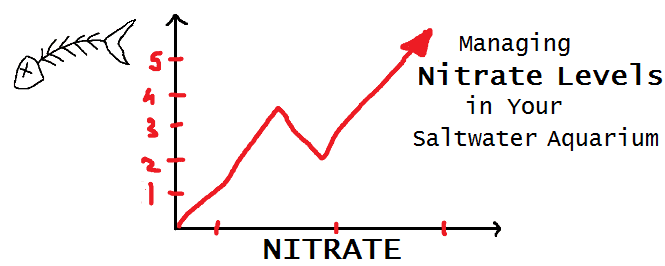
My Conclusion
Remember that there is rarely a remedy that’s going to single-handedly solve the problem in your saltwater aquarium.
Combining methods is the surest way to avoid the possibility of nitrate poisoning for your pet fish.
Nevertheless, it is not that difficult to take care of your setup once you get basic procedures like controlling nitrate levels right.
Keep learning and leave me a comment below if you have any questions.

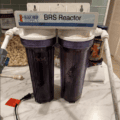





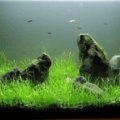
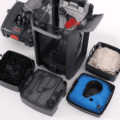
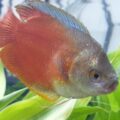
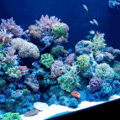
Great post! I never realized how crucial it is to monitor nitrate levels in my saltwater tank. The information on acceptable ranges is super helpful, and I appreciate the tips on how to manage and reduce nitrates effectively. Thanks for the insights!
Hey, no problem! Glad we can help. And thanks for the kind comments, much appreciated.
I found your information informative and easy to understand. You included information not typically covered such as the ratio of nitrate to phosphate. I like the multiple approaches and the pros and cons of each. Hopefully I have learned something new and will apply it successfully.
I have a 100 gal reef tank re-established about 10 years ago. While I have made maintenance mistakes I felt my overall success was pretty good. I had to relocate the tank about 9 months ago and things seem to go down hill, primarily the bleaching of long established Monti’s. The primary difference I have been able to identify is the increase in nitrates. While previously I did not check nitrates regularly, as they were usually close to 0, I now struggle to keep them below 20.
Thank you for your web site.